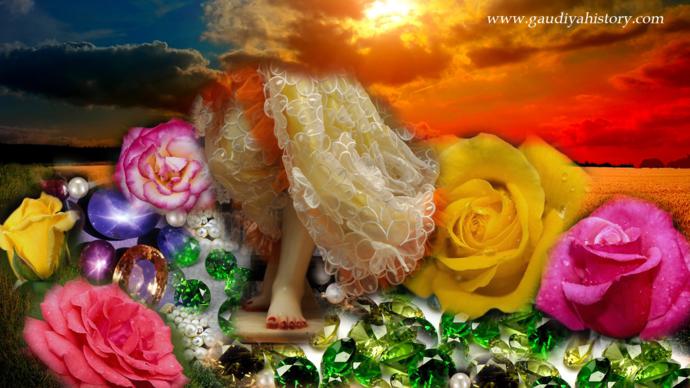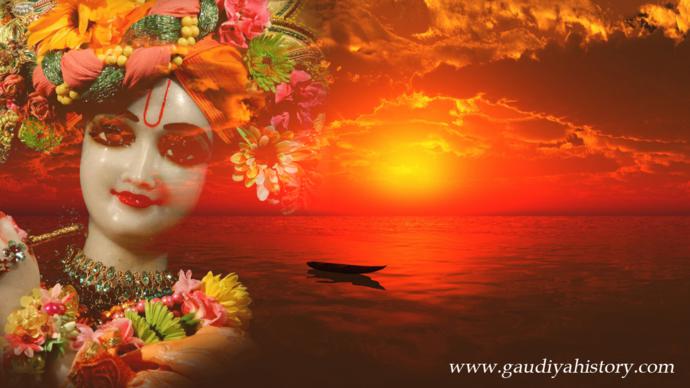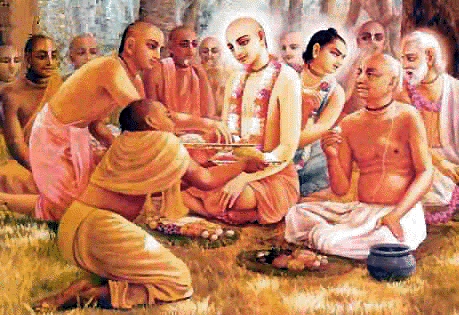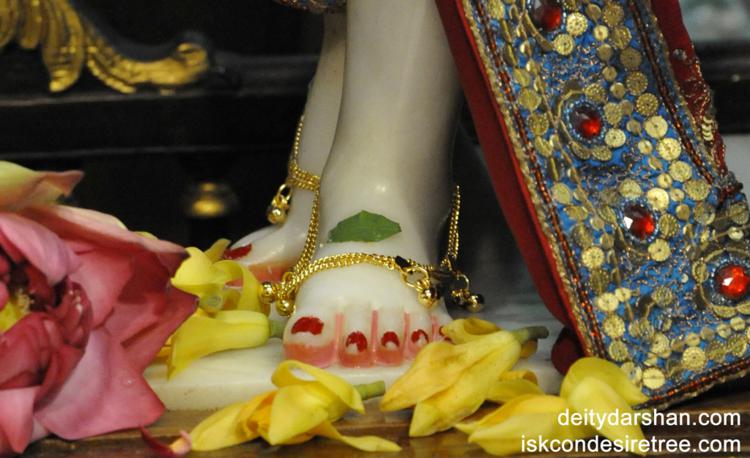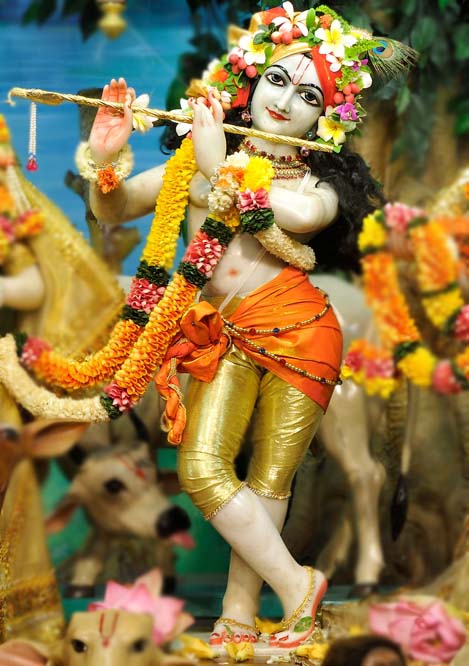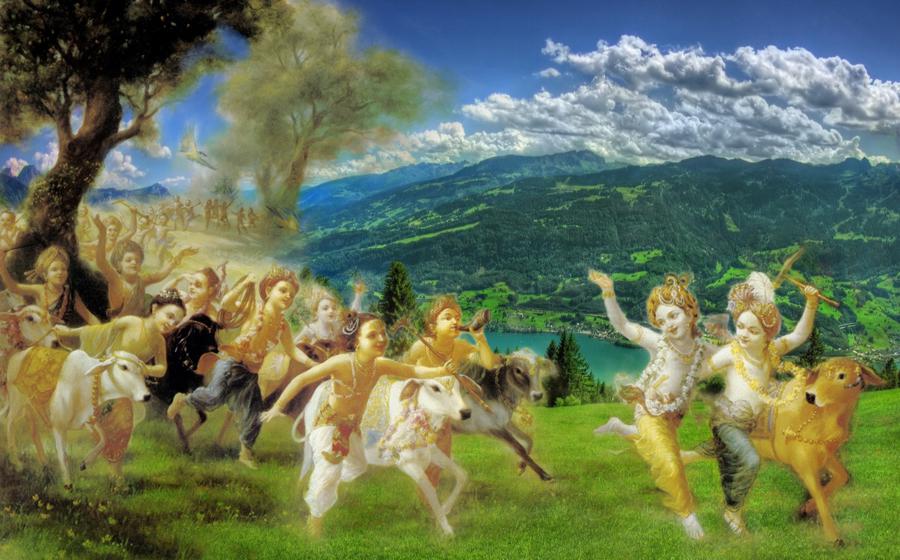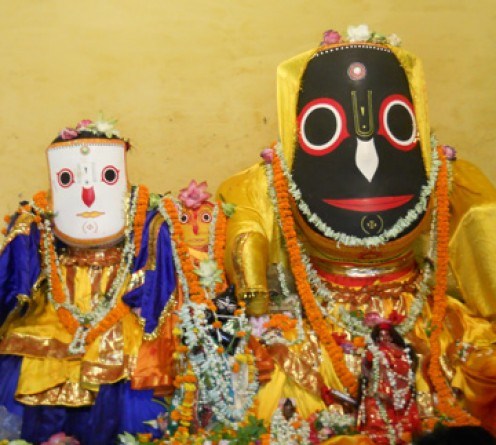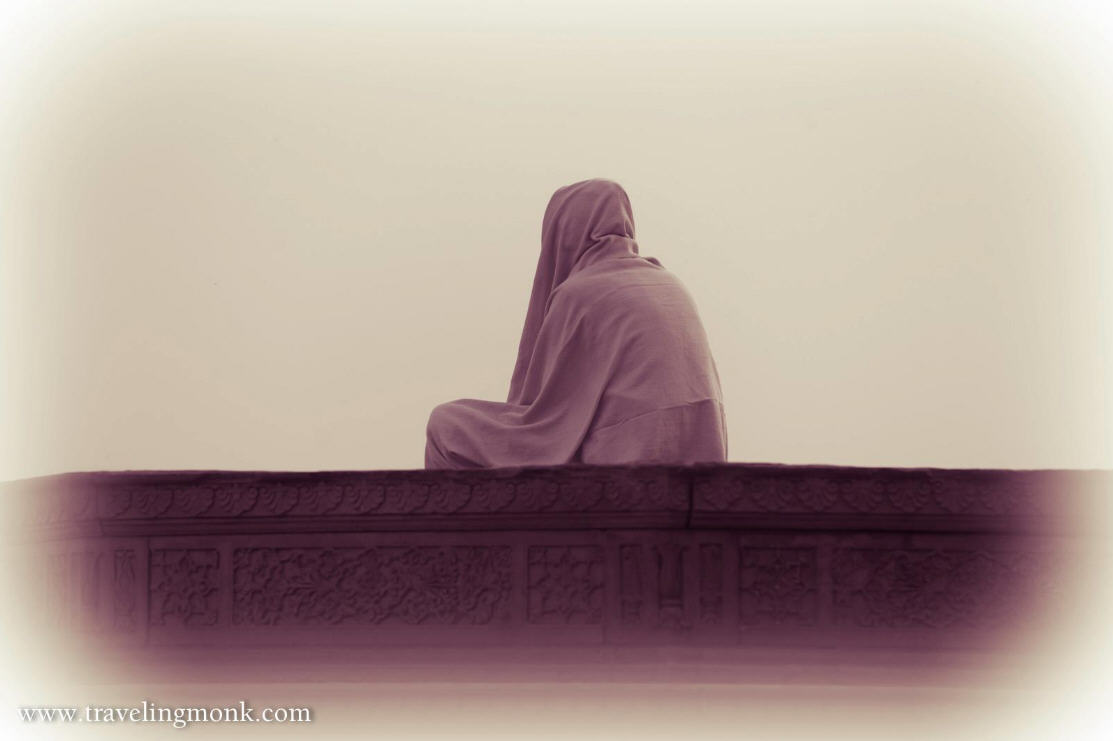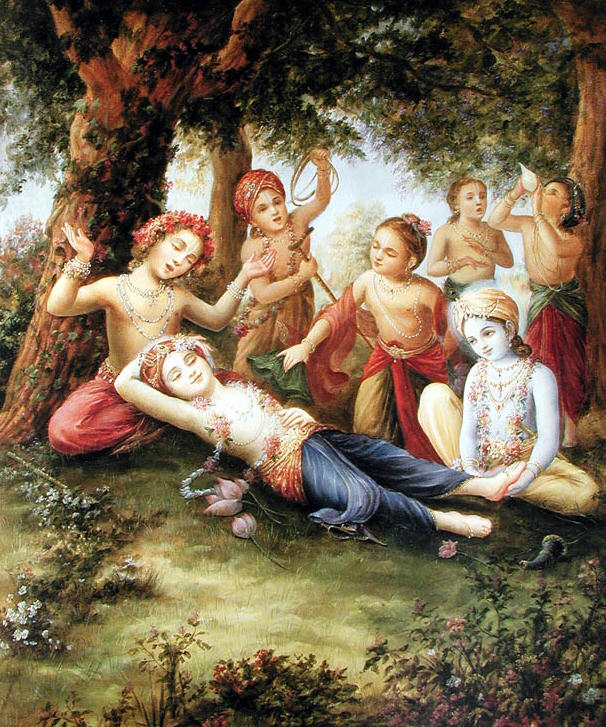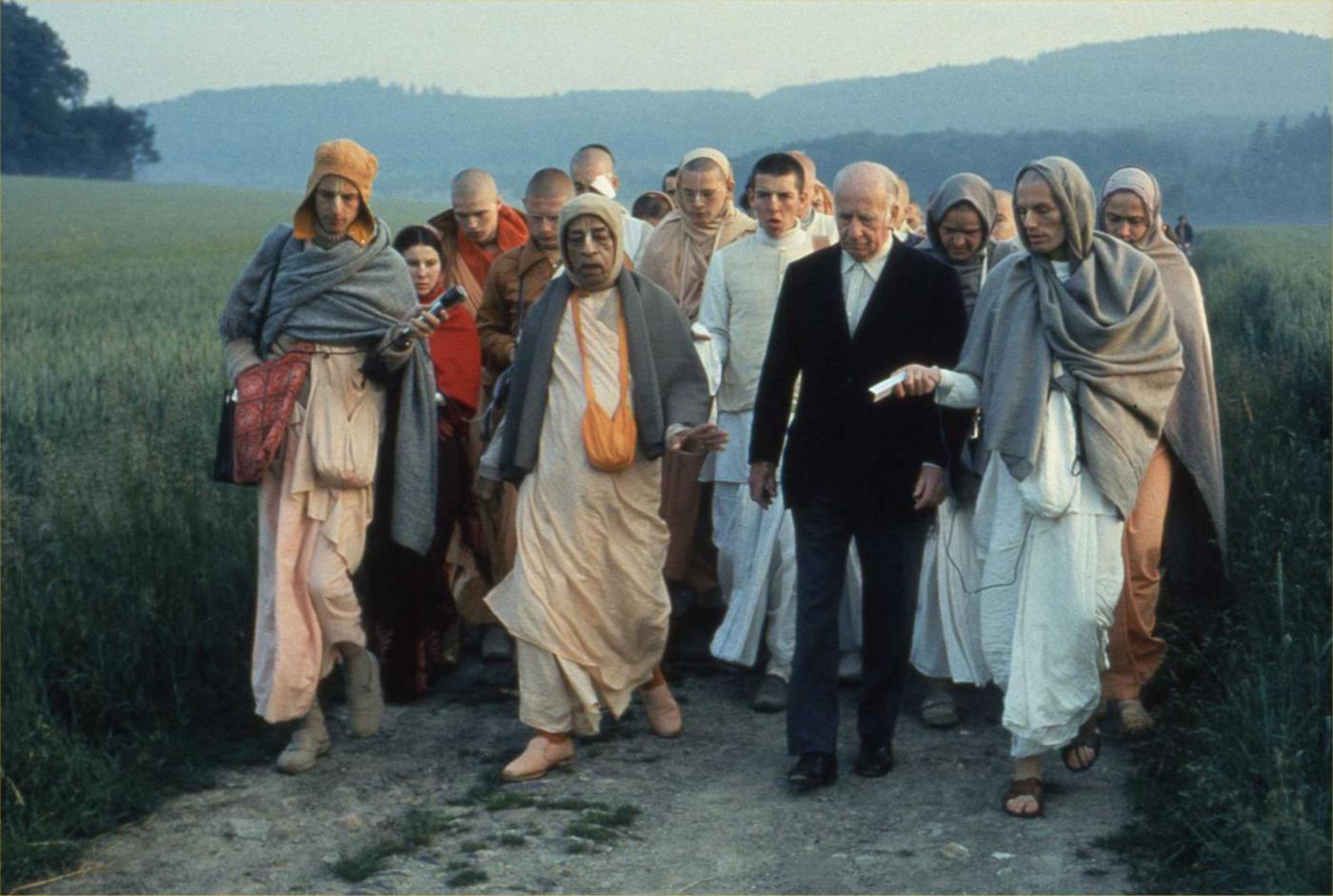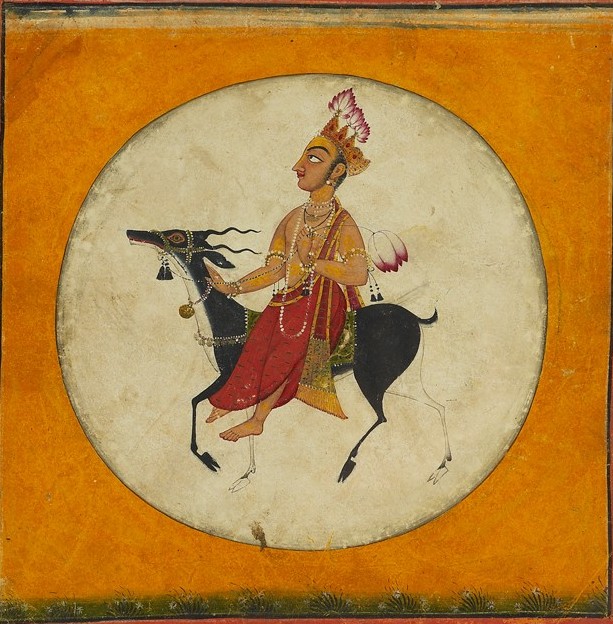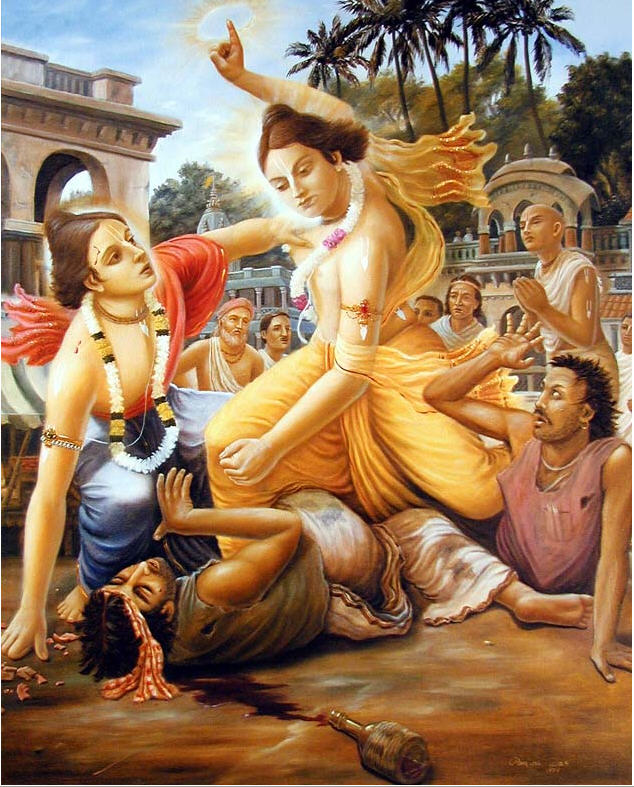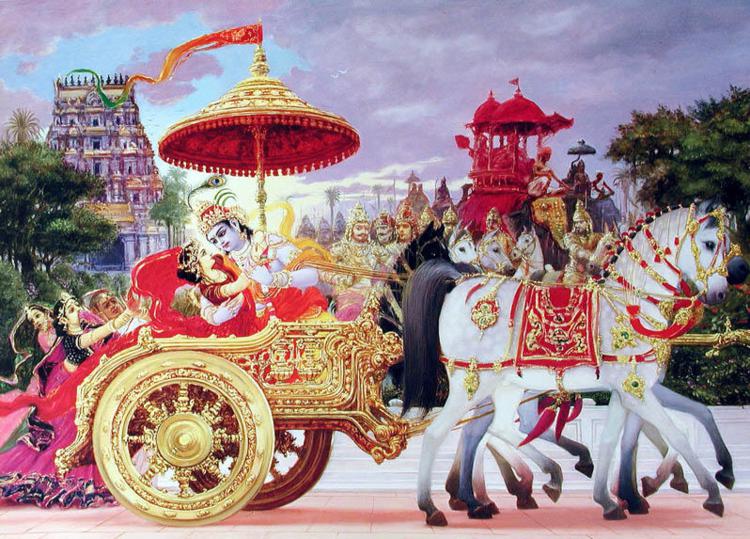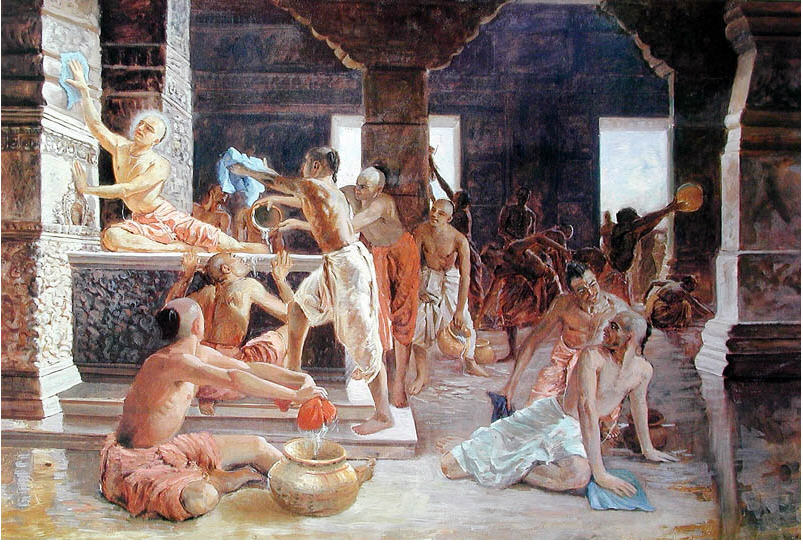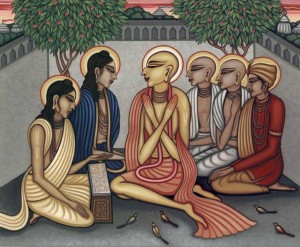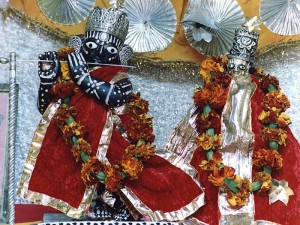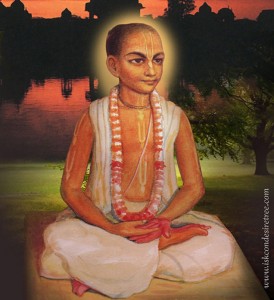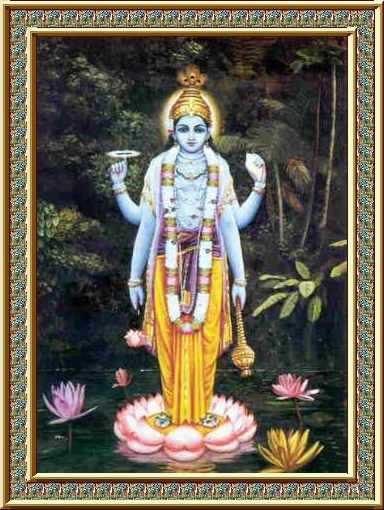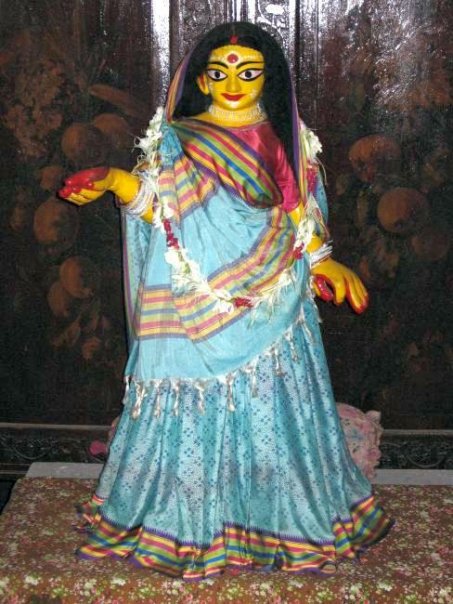puri paramanando ya asid uddhavah pura
He who was Uddhava in Krishna-lila came to enrich the pastimes of Gaura as Paramananda Puri.
(Gaura-ganoddesha-dipika 118)
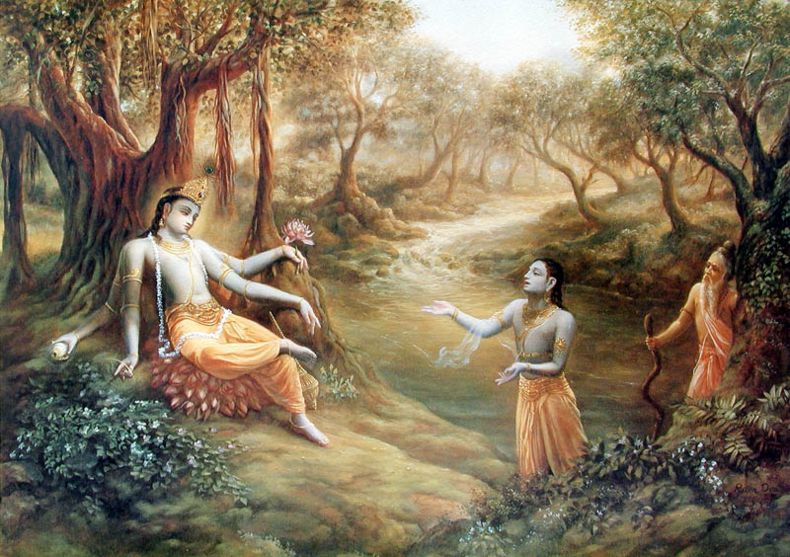
He who was Uddhava in Krishna-lila came to enrich the pastimes of Gaura as Paramananda Puri. (Gaura-ganoddesha-dipika 118) (In the image: from left to right Lord Krishna, Uddhava, Maitreya Rshi).
Nothing is known about Paramananda Puri’s antecedents nor about his appearance and disappearance dates. It is known that he was born in Tirhut, the area which surrounds Muzaffarpur and Darbhanga in Bihar. Shrila Bhaktisiddhanta Saraswati Goswami Thakur has described him as a Brahmin from Tirhut.
His diksha guru was Madhavendra Puri, as a result of which he was treated as a very dear superior by Mahaprabhu. Krishnadas Kaviraj Goswami has described Paramananda Puri as one of the nine sannyasi roots which came out of the trunk of the desire tree of devotion (Chaitanya Charitamrita 1.9.14). The first sprout of this desire tree was Madhavendra Puri; its well-nourished second sprout was Ishvara Puri; its trunk was Chaitanya Mahaprabhu Himself. The entire tree remained stable sitting on nine sannyasi roots: Paramananda Puri, Keshava Bharati, Brahmananda Puri, Brahmananda Bharati, Vishnu Puri, Keshava Puri, Krishnananda Puri, Nrisingha Tirtha and Sukhananda Puri. Of these nine, Paramananda Puri is the central root. The great mystery here is that Chaitanya Mahaprabhu could both be the trunk of the tree and the gardener who takes care of it.
The central root of the tree was the grave and sober Paramananda Puri. The tree stood solidly on these nine roots.
(Chaitanya Charitamrita 1.9.16)
Mahaprabhu’s Meeting with Paramananda Puri
When Mahaprabhu left Nilachala to do a tirtha-yatra of Southern India in the company of Krishna Das Vipra, He traveled through Kurmasthana, Jiyada-Nrisingha, Vidyanagara where He met with Raya Ramananda, Gautami Ganga, Mallikarjuna, Ahobala Nrisingha, Siddhabata, Skandhakshetra, Trimatha, Vriddhakashi, Bauddhasthana, Tirupati, Trimalla, Pana Nrisingha, Shiva Kanci, Vishnu Kanci, Trikalahasti, Vriddhakola, Shiyali Bhairavi, the banks of the Kaveri River, Kumbhakarna’s forehead, Shrirangam (where he bestowed bhakti on Vyenkata Bhatta and his entire family).
When he arrived at Ashabha Mountain He met Paramananda Puri for the first time. Ashabha Parvata is in the state of Tamil Nadu in Madurai district. Twelve miles north of the town of Madurai are the Anagadamalaya mountains where Rshabhadeva was burned in a forest fire in the forest surrounding Kutakachalam. The place is known today as Palni Hill, or Varaha Parvata, according to the local people. Paramananda Puri was observing the Chaturmasya-vrata at this Ashabha Parvata when Mahaprabhu arrived there. The Lord paid his obeisances to Paramananda, who stood up and embraced him. The two of them spent three days discussing topics of Krishna. When Puri told the Lord of his intention to travel north to Puri and then continue on to bathe in the Ganges, Mahaprabhu invited him to return to Puri afterwards and join Him. He said that He Himself would quickly return from Setubandha to Puri where they would meet again.
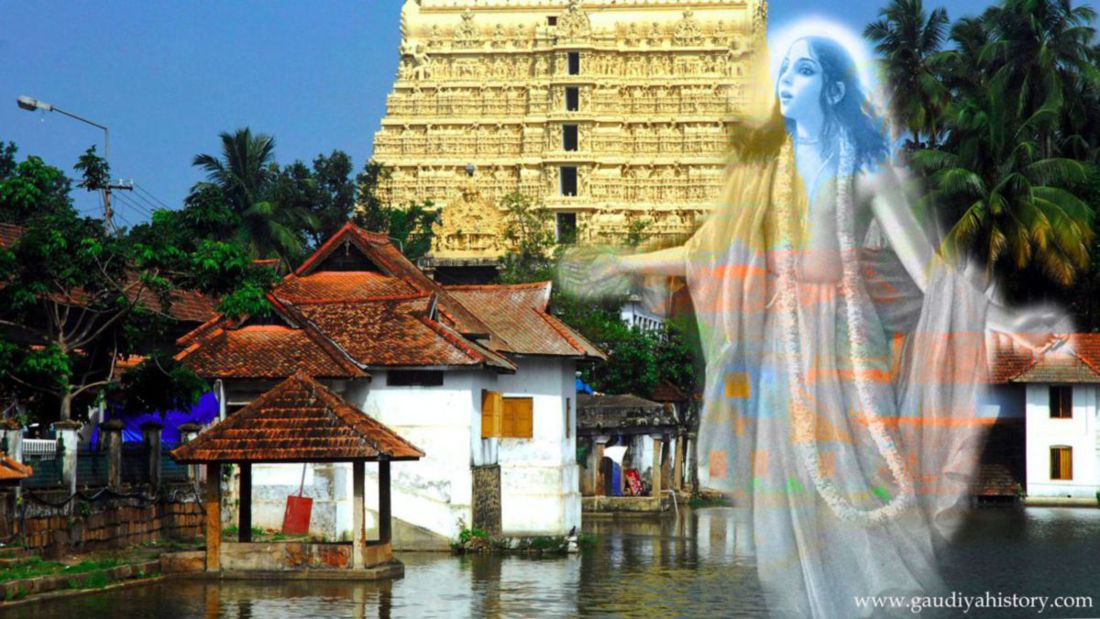
When Mahaprabhu left Nilachala to do a tirtha-yatra of Southern India in the company of Krishna Das Vipra, He traveled through Kurmasthana, Jiyada-Nrisingha, Vidyanagara where He met with Raya Ramananda, Gautami Ganga, Mallikarjuna, Ahobala Nrisingha, Siddhabata, Skandhakshetra, Trimatha, Vriddhakashi, Bauddhasthana, Tirupati, Trimalla, Pana Nrisingha, Shiva Kanci, Vishnu Kanci, Trikalahasti, Vriddhakola, Shiyali Bhairavi, the banks of the Kaveri River, Kumbhakarna’s forehead, Shrirangam (where he bestowed bhakti on Vyenkata Bhatta and his entire family). (In the wallpaper: Lord Chaitanya's travel to South India, Shri Padmanabha Swami Temple, Kerala).
Puri Goswami said, "I intend to go to Puri. After visiting Puri, I will go on from there to Bengal where I will bathe in the Ganges." The Lord said, "Come back again to Puri afterward. I will be there before long after I have visited Setubandha. It is my wish to stay with you, so please be kind to me and come and take up permanent residence in Puri."
(Chaitanya Charitamrita 2.9.171-3)
Paramananda Goes to Puri
When Mahaprabhu returned from His southern tour to Nilachala, He sent Kala Krishna Das to Navadwip to announce to Sachi and the other Devotees that He had returned. They were all overjoyed by the news, and then Advaita Acharya and the others took Sachi’s permission to visit the Lord in Puri. Paramananda Puri happened to be in Navadwip at the time, as he had been walking along the Ganges. He had been staying in Mayapur at Sachi Mata’s house where she had been taking care of him with great affectionately. He thus also learned from Kala Krishna Das that Mahaprabhu had returned to Nilachala. Feeling an intense eagerness to see the Lord again, he and another Devotee, Kamala Kanta Dvija, immediately left for Puri.
Once again, Mahaprabhu respectfully paid obeisances to Paramananda Puri, while he was overwhelmed with feelings of ecstasy and took the Lord in his arms. They each told the other how much they desired their association.
The Lord said, "I desire very much to remain in your company. I request you to be merciful to Me and take up residence in Nilachala." Puri answered, "And I too am very eager to remain in your company. It is for that reason that I left Bengal to come here to Nilachala."
(Chaitanya Charitamrita 2.10.17-8)
Mahaprabhu gave a secluded room in Kashi Mishra’s house to Paramananda Puri as living quarters. Paramananda Puri was therefore always present during the Chaturmasya period, participating in all of the Lord’s pastimes during that time along with His others associates.
We can see from Vrindavan Das’s Chaitanya Bhagavat just how dear Paramananda Puri was to Mahaprabhu:
Mahaprabhu saw Paramananda Puri from a distance and He immediately got up respectfully. Joyful to see His Devotee, the Lord glorified him and danced in ecstatic love. Lifting His arms, He cried out "Hari! Hari! I have finally seen Paramananda Puri with My own eyes! My eyes have been fulfilled, My life has finally been perfected! All My religious works have finally borne fruit. My sannyasa has been fulfilled. It is as though I am seeing Madhavendra Puri himself." Having said this, the Lord took His dear Devotee to His chest and bathed His body with the tears from His lotus eyes. Puri also forgot himself in ecstasy as soon as he saw the Lord’s moonlike face. For some time the two paid obeisances to each other. Paramananda Puri is the abode of love for Chaitanya Mahaprabhu. (Chaitanya Bhagavat 3.3.168-175)
Only Svarupa Damodar was as dear to the Lord as Puri Goswami. Amongst all the sannyasis, there was no one as dear to the Lord as Puri Goswami. Svarupa Damodar and Paramananda Puri are the most qualified of the sannyasi associates of the Lord. The two of them remained constantly in the Lord’s company, taking the staff (danda) in renunciation for the Lord. Puri engaged primarily in meditation, while Svarupa Damodar engaged in kirtan. They were like two arms of the Lord’s form as a sannyasi. (Chaitanya Bhagavat 3.10.42, 46-49)
Paramananda’s Activities with the Lord in Puri
Mahaprabhu ostracized Chota Hari Das for having talked to a woman, refusing him entrance to his house. Chota Hari Das was greatly distressed by this punishment and fasted for three days. Svarupa Damodar and the rest of Mahaprabhu’s entourage repeatedly asked the Lord to soften his stance toward Hari Das, but he would not be shaken. Indeed, he rebuked the devotees for suggesting that he repeal his order. When the devotees learned that Chota Hari Das intended to commit suicide because he was no longer allowed to see the Lord, they came to Paramananda Puri as a last resort to ask the Lord to forgive him. The Lord considered Paramananda Puri to be as worshipable as his own guru, as he was Ishvara Puri’s godbrother. The devotees hoped that if he were to approach the Lord on behalf of Chota Hari Das, that the Lord would accept his demand.
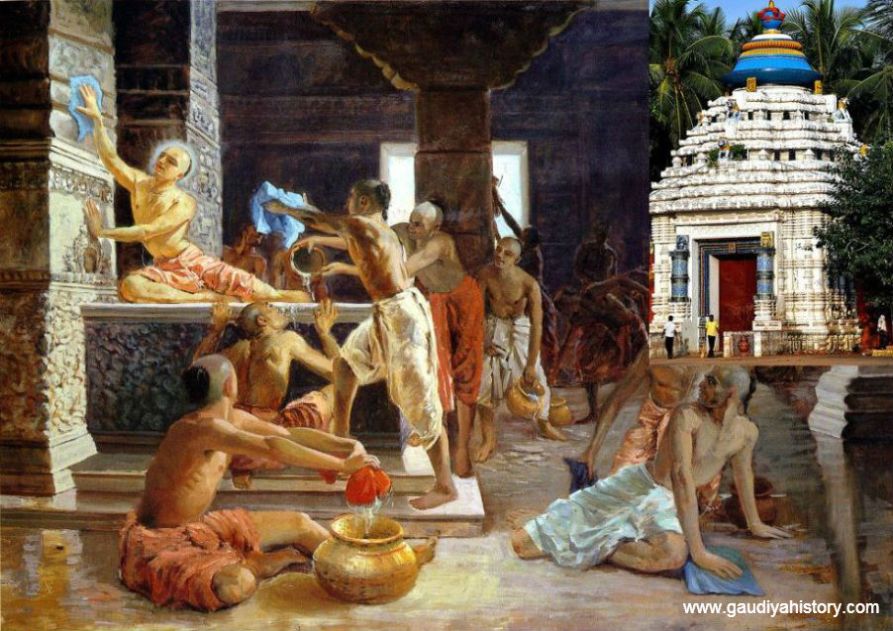
During the Gundicha Temple cleaning, He did not engage His guru-varga in any of the difficult tasks like carrying buckets of water. Rather, they were engaged in cleaning alongside the Lord with the water the other Devotees had carried in. (In the wallpaper: Cleaning of the Gundicha Temple, in the above right is the Gundicha Temple, Puri).
When Paramananda came to Mahaprabhu, the Lord said that he was willing to allow Chota Hari Das to return to His house, but that He Himself would go to Alalanath. Paramananda Puri was taken off guard by Mahaprabhu’s intention to leave Puri. He said that He was the independent Lord and that it had been incorrect of him to try to interfere with His decision. He then tried to dissuade Mahaprabhu from going to Alalanath.
Mahaprabhu taught by His own behavior that the guru’s godbrother is worshipable, like the guru. It is extremely detrimental to one’s devotional life to disrespect those who are one’s guru-varga. The Lord says, "I cannot tolerate breaches of Vaishnava etiquette." (Chaitanya Charitamrita 1.4.166)
Paramananda Puri participated in nearly all of the Lord’s pastimes in Purushottam: the cleaning of the Gundicha Temple, the Rathayatra festival, the water sports in the Narendra Sarovara. He was present at the festival in honor of Hari Das Thakur after his disappearance. Once the Bengali Devotees returned home after the rainy season, Saravabhauma Bhattacharya invited either Mahaprabhu or one of his ten sannyasi associates (Paramananda Puri, Damodar Svarupa, Brahmananda Puri, Brahmananda Bharati, Vishnu Puri, Keshava Puri, Krishnananda Puri, Nrisingha Tirtha, Sukhananda Puri, and Satyananda Bharati) to take lunch at his house every day for a month. Five of these days were consecrated to nicely feeding Paramananda Puri with delicious Maha Prasada.
All the Gaudiya Vaishnavas and the residents of Puri treated Paramananda Puri as a senior spiritual leader and gave him all respect. Mahaprabhu Himself followed the etiquette of placing sandalwood paste and giving garlands to Paramananda Puri and Brahmananda Bharati before anyone else during the Rathayatra festival. During the Gundicha Temple cleaning, He did not engage His guru-varga in any of the difficult tasks like carrying buckets of water. Rather, they were engaged in cleaning alongside the Lord with the water the other Devotees had carried in.
Paramananda Puri and Brahmananda Bharati were overjoyed to receive the sandalwood paste from Mahaprabhu’s own hand. Advaita Acharya and Nityananda Prabhu were also ecstatic to receive the touch of the Lord’s hand. (Chaitanya Charitamrita 2.13.30-1)
Except for Nityananda, Advaita, Svarupa, Brahmananda and Paramananda Puri, all the other Devotees carried water. (Chaitanya Charitamrita 2.12.109)
Paramananda Puri’s Well
The Vyasadeva of Lord Chaitanya’s pastimes, Vrindavan Das Thakur describes Paramananda Puri’s glories in the Chaitanya Bhagavat (Antyakhanda, chapter 3), especially mentioning his well. Shrila Bhaktisiddhanta Saraswati Goswami Thakur makes the following remarks about Paramananda Puri’s well in his Bhashya on the Chaitanya Bhagavat: "This well is not far along the road leading west from the Jagannath Temple. Shrila Bhaktivinoda Thakur pointed this well out as being that of Paramananda Puri. It is just next to the police station."
Just as Krishna engaged in intimate conversation and discussions with His friend Arjuna, so too did Mahaprabhu spend entire days conversing with Paramananda Puri about Krishna. Mahaprabhu knew that the water from this well was not good through His omniscience; later He heard the same thing directly from Paramananda himself. Jagannath knew that any living being who touched or drank the water from Paramananda’s well would be freed from all his sins and thus liberated, thus He Himself had made the water of this well muddy in order to discourage anyone from taking it. This was a sign of Jagannath’s miserliness, as He did not seem to want anyone to have this opportunity to attain liberation. Mahaprabhu thus stood up and prayed with arms upraised, asking Lord Jagannath to be merciful to the jivas.
Lord Jagannath, grant Me this boon: Let the Ganges river enter into this well. Please order the Bhogavati Ganga, which travels underground, to flow into the well. (Chaitanya Bhagavat 3.3.235-6)
When the Devotees heard the Lord’s sweet prayer, they all shouted the names of Hari in approval. Taking the order of the Lord seriously, Ganga Devi entered into the well. The next morning, the Devotees were amazed and overjoyed to see that the water in the well was pure and clear. Paramananda Puri glorified the well, saying that anyone who takes a bath with this water will obtain the same benefits as from bathing in the Ganges and would attain devotion to Krishna. Mahaprabhu Himself bathed in the well’s water and drank from it. Just as the Devotee glorifies the Lord, so too does the Lord sing His Devotee’s glories and seeks to increase them. Those who are uninterested in the Supreme Lord are incapable of understanding the glories of a Devotee. The compassionate Lord glorifies the Devotees so that everyone could learn that without the association of Devotees and without their mercy, there is no such thing as auspiciousness for the jiva.
The Lord said, "I am present on this earth only out of affection for Paramananda Puri. I belong to him alone. If he sells Me, I allow Myself to be sold. Anyone who sees Paramananda Puri, even once, will receive love for Krishna." (Chaitanya Bhagavat 3.3.255-7)
In the Gaudiya Vaishnava Abhidhana, it is said that Paramananda Puri wrote a book named Govinda-vijaya.
[Excerpted from “Shri Chaitanya: His Life & Associates” by Shrila Bhakti Ballabh Tirtha Maharaj].
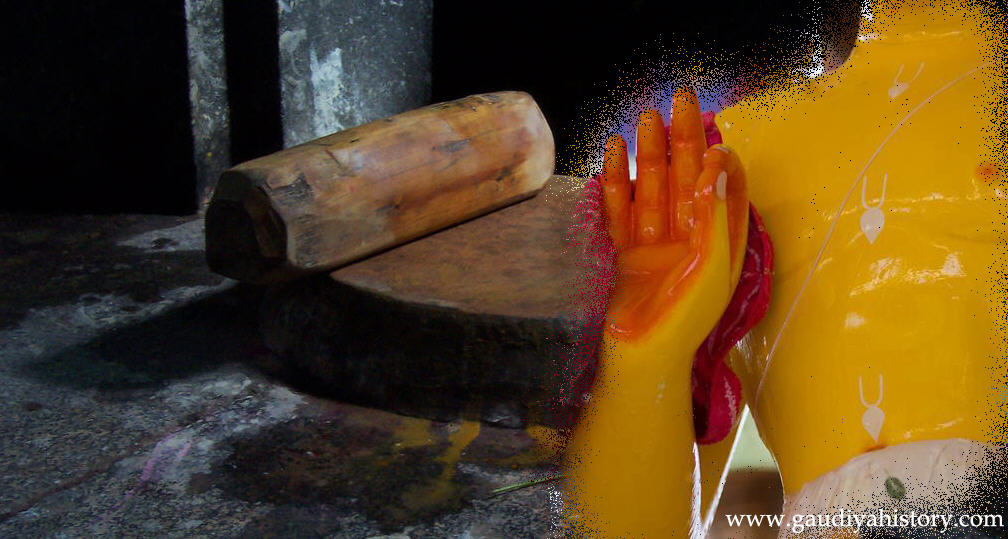
Mahaprabhu Himself followed the etiquette of placing sandalwood paste and giving garlands to Paramananda Puri and Brahmananda Bharati before anyone else during the Rathayatra festival. (In the wallpaper: Sandal wood, Lord Chaitanya's Lotus hand, Simantadwipa, Shri Navadwipa Dham).
